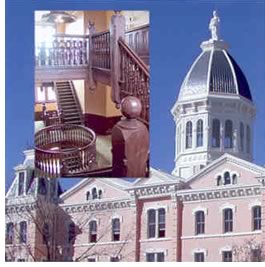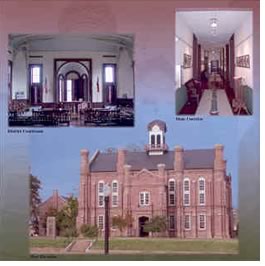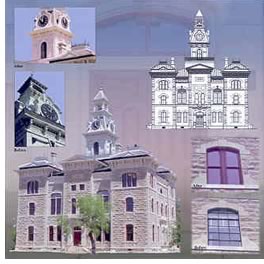
State advances historic courthouse renovations

Associate Editor
When Texas entered the union in 1846, courthouses were among the first permanent structures built in newly designated counties. They are now a link to the past, embodying the spirit of democracy, and their design reflects the character of the economic, social, and political influences of their time. Often at the crossroads of their communites, many historic courthouses are now at a turning point themselves, with more than 200 on the National Trust for Historic Preservation list of America's most endangered structures.
All politics (and
most architecture) is local
Texas's courthouses are the victims of structural problems, outdated electrical
and mechanical systems, and leaking roofs. They are not ADA compliant,
are vulnerable to fire and abandonment, and are often at the mercy of
those who want to build new rather than renovate and preserve.
 Architects
and historic preservationists in Texas have long recognized the need to
devote more financial resources to courthouse restoration, as many of
the buildings are excellent examples of architectural styles ranging from
Gothic-Revival, Art Deco, and Neoclassical to Renaissance-Revival, Romanesque-Revival,
and Second Empire. The Trust called the courthouses "some of the
finest works of public architecture nationwide."
Architects
and historic preservationists in Texas have long recognized the need to
devote more financial resources to courthouse restoration, as many of
the buildings are excellent examples of architectural styles ranging from
Gothic-Revival, Art Deco, and Neoclassical to Renaissance-Revival, Romanesque-Revival,
and Second Empire. The Trust called the courthouses "some of the
finest works of public architecture nationwide."
County judges and other proud patrons of the courthouses also sounded the alarm and embraced the idea of restoring the increasingly dilapidated and dangerous structures, which until that point had only been served by piecemeal, unsympathetic renovations.
In 1998, after the National Trust had placed the state's 225 historic courthouses on its annual "Most Endangered Historic Places" list, these historians and preservationists found that they had a powerful ally in the Texas statehouse—the governor and his closest advisers. Responding to urgency of the Trust's designation and pleas to preserve the edifices, then-Governor George W. Bush called on the Texas legislature to provide assistance to communities to make the county courthouses safe and functional and asked the Texas Historical Commission to develop a matching grant program to accomplish these goals.
Architects work with
politicians
Architects and leaders in historic preservation, such as Kim Williams,
AIA, principal of The Williams Company, Austin, Tex., and organizations
such as Preservation Texas, worked to educate reluctant politicians on
the benefits of the funding program and created a display for exhibition
at the statehouse in Austin. (The display has since become a traveling
exhibit for others interested in developing similar programs. And, as
a reminder of the importance of the program, it returns to the Texas statehouse
when the legislature is in session.) They also lobbied their lawmakers
so they would understand how important courthouse restoration was to county
judges and their local constituencies.
 As
a result, in 1999, with an initial appropriation of $50 million for matching
grants, Bush and the Texas legislature created the Texas Historic Courthouse
Preservation Program. Another round of funding followed, and the most
recent money was distributed to 14 more counties earlier this year. To
participate in the program, counties must submit a Preservation Master
Plan for restoring and maintaining their historic county courthouses.
A county's plan may be accepted or rejected, and a grant application may
only be submitted on final approval of the plan.
As
a result, in 1999, with an initial appropriation of $50 million for matching
grants, Bush and the Texas legislature created the Texas Historic Courthouse
Preservation Program. Another round of funding followed, and the most
recent money was distributed to 14 more counties earlier this year. To
participate in the program, counties must submit a Preservation Master
Plan for restoring and maintaining their historic county courthouses.
A county's plan may be accepted or rejected, and a grant application may
only be submitted on final approval of the plan.
Williams said he suspects that Bush understood the important place historic courthouses held in the heart of local judges and other opinion makers in Texas. Williams noted that Bush visited 22 courthouses during his campaign for presidency—frequently visiting democratic districts—and often used courthouse renovation projects as a backdrop for political events.
Preserving the endangered
courthouses: "This is my courthouse."
The first three counties to complete their courthouse restorations through
the matching grant program were Shackelford, Presidio, and Grimes.The
Shackelford and Grimes courthouses were fully restored to their Italinate
style, and the Presidio courthouse to its Second Empire glory.
The original grand Shackelford County Courthouse was a replacement for a simple picket-type building erected in the center of a larger square in 1874 to serve as the new courthouse for the recently established community. However, according to the authors of For 500 Years: The Shackelford County Courthouse, its people had grander plans, envisioning a formidable structure that would symbolize the strength and stability of the community. They built a stone structure that would be passed down to future generations.
 Williams
was the architect working to restore the Shackelford Courthouse. His company
was selected in 1995 and funded by a federal/state transportation grant
and local donations to work on the courthouse roof and clock tower. For
the next six years, The Williams Company worked closely with the local
government to create its Historic Courthouse Preservation Plan, which
guided the project through a full interior and exterior restoration and
secured more than 80 percent of the funding necessary to complete the
project.
Williams
was the architect working to restore the Shackelford Courthouse. His company
was selected in 1995 and funded by a federal/state transportation grant
and local donations to work on the courthouse roof and clock tower. For
the next six years, The Williams Company worked closely with the local
government to create its Historic Courthouse Preservation Plan, which
guided the project through a full interior and exterior restoration and
secured more than 80 percent of the funding necessary to complete the
project.
Williams also worked on the "top to bottom" restoration of the Presidio County Courthouse of 1886 in Marfa, Tex. He and his team directed a talented group of craftsman through the refinishing and repair of the interior and exterior surfaces. Despite some debate as to the interior paint colors and carpet, the final project represents a "fully authentic 1915 restoration scheme," according to Williams.
Williams said courthouse restoration projects present some unique challenges, because so many people, from powerful judges to ordinary people, have emotional and political connection to the outcome of the restoration. "Everybody in the community thinks, 'this is my courthouse,'" he said.
Renovation stories are often colorful, too. For example, Williams said the scales of justice had been shot off the tower of one courthouse. Citizens insisted that he not "over-renovate" by re-introducing the scales back into the design scheme, because their absence is a part of the local history.
Getting the job done
A conversation with Williams revealed that it is important to have both
the technical know-how and the political savvy to educate politicians
and the public about prospective projects and get local officials involved
in the process. He said many politicians are afraid of traditional town-hall
meetings because they may stir up and propagate negative feelings. Williams
stressed the importance of hearing what the "coffee shop crowd"
has to say and making them feel invested in the upcoming work. Most often,
he said, it becomes a win-win situation for the planner and the community.
Williams also pointed out that a high-profile restoration project often precedes more comprehensive restoration efforts. For example, one town used its courthouse restoration to spur the renewal of the main-street neighborhood. Other courthouses are now used for changes of venue and for law students involved in mock trials. Some have become historic tourist attractions.
The Texas Historic Courthouse Preservation Program continues to evolve. Many counties are applying and reapplying for the matching grants. The THC plans to continue the program as long as it is reauthorized by the state legislature.
Copyright 2002 The American Institute of Architects. All rights reserved.
![]()
|
Photos courtesy of the architect. |
|